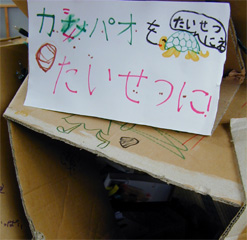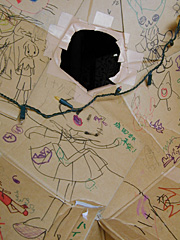 |
 |
 |
 |
 |
Impressions of Kamepao
by David Colosi
The following reports were written for our web pages on "Kamepao Workshop '99 (Jul.27 - Aug.05 1999, in Shizuoka JAPAN)" by David Colosi one of our collaborators at that time.
|
 |
 |
A First Impression of Kamepao, 7/27/99
After a year of wear, the cardboard box Kamepao at Agora seems to have shrunk about a foot. The "entrances" and "exits" are reinforced with tape, ruffled at the edges, torn, and/or squashed from excessive use. Images of characters, both popular and unique, are scribbled on the boxes. Names of these characters, names of children, sentences, and cartoon bubbles give the shelter a distinctive voice. The evidence of children, and a history of children, is apparent. An added triangular piece, obviously doubling as a signboard and a wedge for reinforcement, has the sentence:  . This could be read in one sense as: "Use Kamepao wisely." A direct translation of . This could be read in one sense as: "Use Kamepao wisely." A direct translation of  would be "important", therefore, "because Kamepao has importance, be considerate of it." In the same way that water serves our benefit, pleasure, and necessity, where to waste it would be self-destructive, so too does Kamepao. On a first impression, this is how both the children and the Kamepao Project Team view their work. would be "important", therefore, "because Kamepao has importance, be considerate of it." In the same way that water serves our benefit, pleasure, and necessity, where to waste it would be self-destructive, so too does Kamepao. On a first impression, this is how both the children and the Kamepao Project Team view their work.
 
This cardboard box Kamepao is only a sample. Physically it is the actual Kamepao, but it remains a sample. The children that play in this Kamepao take a weekly class to play together, experiment with different ways of making things and seeing, and release anxiety. While the children are here, their parents can use the time without them to relieve their own anxiety or take care of important things for themselves or their families without the constant concern for looking after their children. What makes this a sample is that these children are not the victims of a natural disaster like an earthquake.
The intention of the Kamepao Project team, according to their website, is to create a space for dealing with the psychological trauma that may effect children immediately after an earthquake, or other natural disaster. Kamepao would serve as a site for children to release stress and anxiety resulting from their newly disrupted lives as a consequence of such a disaster. At the same time, it would offer the parents of these children, also victims, time to deal with their own anxiety and stress without the immediate worry of their children, as well as time to deal with repairs, tending to the injured, or any number of necessities that natural disaster brings.
Watching the 4 and 5 year-old children play today, one could easily see how Kamepao enveloped them. With the cardboard box structure as their base, they played inside, outside, and on top of it. Kamepao becomes their structure. As is evidenced by the attention paid to the drawings, writings, made objects attached to it, as well as the general care and repair to the structure itself, Kamepao is not FOR the kids, it is theirs. The fact alone that this structure is still standing in this condition after a year is evidence enough that the children take great care in what is theirs.
In the case of the sample, one member of the Kamepao Project team, Hideo Shibutare is present as teacher, assistant, handy man, and supervisor. He introduces projects that range from making ceramics, to building wooden structures, to making musical instruments, as well as drawing, painting, and writing. But most of the time he stands back and lets the children do what they want. Occasionally they'll call him to spot them as they climb a ladder, or to help them build or cut something. But, I couldn't help also thinking that he plays a role in teaching the children how to care for what is theirs.
When the children realize that Kamepao is for their benefit and use, they learn to care for it. If they destroy it, they destroy their own property. This is among the many things that Kamepao seems to include. Children learn to build, to care for what is theirs, to use their resources wisely, and to work together. They share the roof of this temporary structure and learn to work on it, in it, and out of it. Although children may not be much help in repairing the site of a disaster, in fact they may be a hindrance, Kamepao seems to be an effort to both "repair" children while it teaches them how to repair. At the same time, it seems to be an effort to give the parents of these children their own time to make repairs.
In this sense, as well as others, Kamepao is not simply for kids. The Kamepao Project Team is a group of artists that seems to know how to balance the complex issues of society, culture, the environment, politics, etc. with a simplicity of execution. Neither didactic nor obtrusively activist in their motivation, the Kamepao Project Team communicates to adults and children alike. Their intentions seem to lie between art making and child's play. Their objects are constructed with the care of museum artists, but their function strives for something much deeper than the perception of a viewer.
For them, an artwork goes far beyond an object of self-expression. A look and read through their website clearly shows that a concern for self-profit, recognition of "uniqueness" and personal expression is not what motivates them: They are a non-profit organization; they offer their designs, ideas, and objects to anyone to use; they specifically maintain a policy that they do not own a copyright on Kamepao and that anyone, anywhere, can make it, based on their plans or not; and they don't try to preserve the "preciousness of their objects, as children can make or remake them as they need to.
In the same way that,  , or "Use Kamepao Wisely" serves both as a signboard and a wedge, the Kamepao Project Team hopes Kamepao can have multiple functions - ideological, aesthetic, social, as well as being a practical necessity. , or "Use Kamepao Wisely" serves both as a signboard and a wedge, the Kamepao Project Team hopes Kamepao can have multiple functions - ideological, aesthetic, social, as well as being a practical necessity.
|
|
 |
 . This could be read in one sense as: "Use Kamepao wisely." A direct translation of
. This could be read in one sense as: "Use Kamepao wisely." A direct translation of  would be "important", therefore, "because Kamepao has importance, be considerate of it." In the same way that water serves our benefit, pleasure, and necessity, where to waste it would be self-destructive, so too does Kamepao. On a first impression, this is how both the children and the Kamepao Project Team view their work.
would be "important", therefore, "because Kamepao has importance, be considerate of it." In the same way that water serves our benefit, pleasure, and necessity, where to waste it would be self-destructive, so too does Kamepao. On a first impression, this is how both the children and the Kamepao Project Team view their work.

